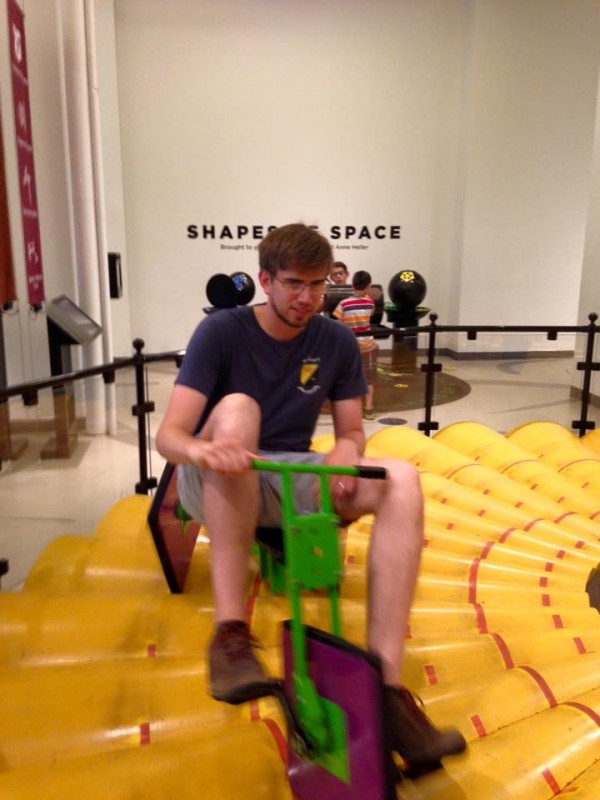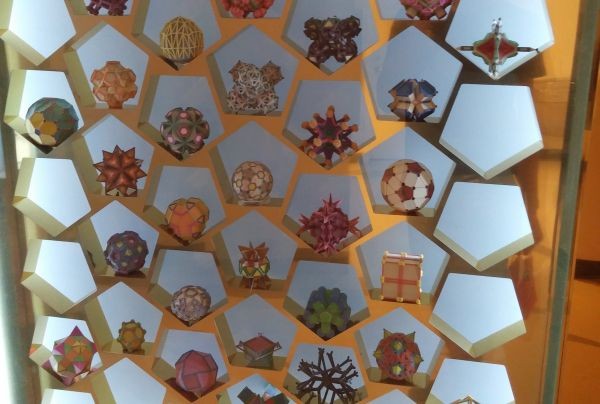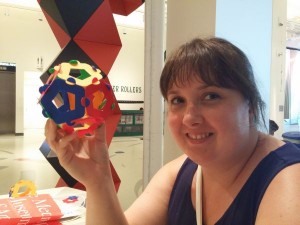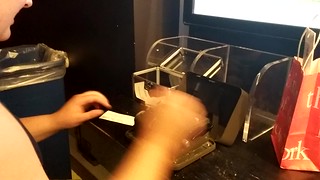This summer my wife and I went to America on our honeymoon. We had a lovely time – it was hot, we saw stripey flags in all sizes, and we marvelled at what substances count as “food” in the land of the free.
But what I really want to tell you about is the National Museum of Mathematics in New York. We couldn’t fly all the way to the East coast of America and not pay a visit. So we did!

MoMath, as it’s known, is more of an exploratorium than a museum – a fairly small space filled with toys and gizmos and whatevers to show rather than tell visitors about interesting mathematical concepts. It’s definitely aimed at kids, of the smallish sort.
Most of the exhibits are big physical constructions you can climb on or fiddle with. Highlights were the raft lying on solids of constant width, and the tricycles with square wheels rolling on a catenary track.

(Behind me in that photo is a pretty cool exhibit which lets you tile surfaces of different curvatures with regular polygons by holding them on with a vacuum. When the vacuum turns off it all falls apart!)
There was a cool gizmo which presents you with a polyhedron on a screen and lets you extrude or squash or twist it to create a funky new shape, using an enormous trackball that wouldn’t look out of place in a cheap 90s fantasy film. There was a cabinet on the back of the machine showing off some shapes that had been 3d printed.

We spent a little while at a table which had a bucket of itsphun plastic polygons, sliding them together to create some shapes. Following the list of ingredients on a help sheet, Helen set to work trying to construct a dodecahedron, adding the requirement that no two touching faces have the same colour. She didn’t manage it, and I didn’t think it could be done, but I’ve just googled it and George Hart proves her right.


The basement had a few more exhibits, quite a few of which were unfortunately broken – since so many of the exhibits rely on technological wizardry, they have trouble standing up to the beatings tiny maths-mad people can inflict. A maintenance chap was valiantly trying to glue a bit of an exhibit back on while kids were crawling over it.
Hidden away at the back was a very sturdy American encryption machine, which was very satisfying to use.
There were some touchscreen information displays dotted about, promising to explain the exhibits in a bit more depth, once you’ve played with them and had time to think and discover for yourself. I would’ve preferred something more direct, though.
We just had a few minutes to look at the shop before the museum closed. That was lucky, because we could have spent a fortune in there! I don’t think I’ve ever seen so much fun maths stuff gathered in such a small space. It was all very reasonably priced, too. We bought a small pack of itsphun shapes – enough to make each of the Platonic solids – for a couple of dollars, a t-shirt featuring the excellent MoMath logo, a teeny tiny card game called Iota, which is like a cross between Set and Scrabble, and a set of Platonic solid dice.
All in all, we were only in the museum for about an hour. Helen really liked it, despite being very much disinclined to like maths. I enjoyed it, but nothing really blew me away. It’s worth popping in if you’re in New York. I think the real value might be in the events they run, with the very best invited guest speakers showing off all sorts of interesting maths.
More information: momath.org
